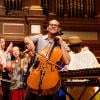
Rhiannon Giddens and Silkroad’s American Railroad tour doesn’t have any West Coast dates scheduled in the coming months, but that’s not surprising, considering that the multicultural juggernaut launched by Yo-Yo Ma roared through the region last November, playing the university circuit with concerts at Stanford, UC Davis, UC Berkeley, and Sonoma State.
Those enthralling performances didn’t just offer a preview of the material from the new album American Railroad, released on Nonesuch Records on Nov. 15. The album actually documents two of the concerts, with all of the material recorded live at Sonoma’s Green Music Center and Berkeley’s Zellerbach Hall.
The album itself is one piece of a multiyear initiative that includes site-specific visual installations, documentary videos, and a now-de rigueur podcast series exploring the history and stories that inspired the music. Produced in partnership with PRX, the first podcast episode was released on Nov. 14.
The concept for the project flowed out of Andrew J. Russell’s iconic 1869 photo East and West Shaking Hands at Laying Last Rail, taken at Promontory Summit, Utah. What caught Giddens’s eye wasn’t the tableau of Reconstruction-era luminaries and laborers. “It was who’s not in the photo,” the singer, songwriter, and multi-instrumentalist said.

There are no Chinese workers in the wide-angle image, and while the contributions of Chinese labor in building America’s first transcontinental railroad is well known, “if you’re talking about the eastern part [of the railway], you’re also talking about Irish people, and you’re talking about the [historical] transition from slavery into convict labor,” Giddens said. “The other missing piece is Indigenous people.”
While Silkroad (formerly the Silk Road Project) was founded in 1998 by Ma to explore the East-meets-West cultural convergence that took place over the course of a millennium along the trading routes linking Asia to the Mediterranean world, Giddens has brought a different perspective to the organization since taking over as artistic director in July 2020. She’s maintained the original mission while adding an Industrial Age East-West conveyance into the picture.
With nine Silkroad Ensemble members and an array of special guests, American Railroad encompasses Native American and African American music as well as traditional songs from Irish, Chinese, Japanese, and other immigrant groups, all reimagined via the group’s singular instrumentation. The cast includes Sandeep Das on tabla, Karen Ouzounian on cello and vocals, Kaoru Watanabe on Japanese flutes and percussion, Mazz Swift on violin and vocals, and East Bay percussionist Haruka Fujii.

Among the featured guests are Francesco Turrisi on frame drums and accordion, Pura Fé on lap steel guitar and vocals, and star jazz singer Cécile McLorin Salvant, who contributes the lament “Have You Seen My Man?”
Giddens presides over the disparate ensemble on banjo and vocals, though she credits Wu Man, a master of the pipa, a lute-like traditional Chinese instrument, with providing much of the glue that holds all the elements together. A founding member of the Silkroad Ensemble, Wu Man is well known to Bay Area audiences and often described by violinist David Harrington as “the fifth member of Kronos Quartet.” Her piece “Rainy Day” features Yazhi Guo on suona, a traditional Chinese double-reed instrument with a clarion tone.
Since many of the first wave of Chinese railroad laborers came from the southern province of Guangdong (or Canton), Wu Man looked to those traditions for inspiration. “Among all Chinese traditional music, Cantonese music has such a strong voice and personality, with a distinctive style and language and instrumentation,” she said. “Very different from my hometown. I wanted to have a big-sound instrument, and the suona is played in a lot of local operas. My piece is like an aria for my instrument, pipa, [plus] Japanese and Chinese percussion, suona, and voice, which is really not traditional instrumentation.”
The Japanese-born Fujii, who produced the recent cultural festival Nippon Kobo at Fort Mason, arranged the percussion-driven “Tamping Song.” A longtime Silkroad Ensemble member, she sees Giddens’s vision for the organization as an extension of “Yo-Yo’s simple curiosity about what happens when strangers meet,” she said. “That’s been fueling this train for 25 years.”
In researching the history of the transcontinental railroad, Fujii discovered the little-known story of some 13,000 Japanese laborers who arrived after the 1882 Chinese Exclusion Act. “I found this old recording from 1930 on YouTube, a folk song from Japanese railroad workers,” she said. “They must have brought the song to the U.S. It’s about celebrating their work and ambition and the American dream, and it’s all about this motion — tamping, swinging the hammer to nail the spikes.”
Running through American Railroad is Giddens’s arrangement of the bluegrass standard “Swannanoa Tunnel” (also known as “Asheville Junction” and “Swannanoa Town”), whose origins as a 19th-century African American work song are largely forgotten. The primary arrangement is a medley that flows into “Steel-Driving Man,” a lesser-known folk song about John Henry, the hero who triumphed in his race with a steam drill only to die of exhaustion with a hammer in his hand.
Unlike that apocryphal tale, the album doesn’t unfold as a linear narrative. Rather it offers an uncanny soundscape defined by anachronistic musical conversations, as if the peoples who built this protean nation took a time-out to share their feelings and observations about the strange place where they’d landed. If there’s a thread through the music, it’s the steel rails, “the locomotive engine and the movement of the train — or the sound of the workers,” Giddens said. “The audience is on a ride with us.”




